A Multi-Regional Collaborative Optimization Model of Emergency Medical Materials for Responding to COVID-19
Abstract
:1. Introduction
- A multi-objective optimization model for emergency medical material collaborative allocation is formulated, which simultaneously considers time, cost, and loss, and the trade-off between these three decision criteria is explored.
- A multi-regional collaborative allocation approach of emergency medical materials is proposed, which considers a variety of the difference coefficients in different regions, including the vulnerability and importance of demand points, the urgency of demand, the vulnerability of victims, and the timeliness of emergency medical materials.
- An IAGA algorithm is developed to solve the model so that decision-makers can handily select the best possible emergency medical material allocation strategy.
- The advantages of multi-regional collaborative allocation for improving rescue efficiency and effectiveness are illustrated through the case of the collaborative response to the COVID-19 epidemic in the Yangtze River Delta of China.
2. Model and Method
2.1. Problem Description
2.2. Research Hypothesis
- (1)
- The regions are independent of each other and the medical materials for emergency rescue can be transported to each region; all vehicles transporting materials are the same.
- (2)
- The available supply of materials at the supply site within each region in each period is known, and the demand at the affected point within each region in each time period can be estimated through the existing technology and information. The distance from supply site to demand point is known, as well.
- (3)
- Seven days is regarded as one emergency period, and the material requirements of each demand point can be fully satisfied following an entire emergency material allocation period.
2.3. Mathematical Model
- The first objective is to minimize the total time necessary for the collaborative allocation of emergency medical materials, including route transportation time, loading time at the supply site, and unloading time at the demand point.
- The second objective is to minimize the total cost of collaborative emergency medical material allocation, including fixed transportation costs, variable allocation costs, and penalty costs for material shortages.
- The third objective is to minimize the total system loss caused by unmet materials at all demand points.
2.4. Solution Method
3. Case Study and Results
3.1. Case Description and Data Setting
3.2. Result Analysis
3.2.1. Time, Cost, and System Loss of Collaborative Material Allocation per Period
3.2.2. Material Satisfaction Rate of Each Demand Point in Each Period
3.2.3. Allocation Path and Amount of Various Types of Materials in Each Period
3.2.4. Comparison of Collaborative and Non-Collaborative Allocation
3.2.5. Verification of IAGA Effectiveness
4. Conclusions and Outlook
Author Contributions
Funding
Institutional Review Board Statement
Informed Consent Statement
Data Availability Statement
Conflicts of Interest
References
- Pollack, H.A. Disaster preparedness and social justice in a public health emergency. J. Health Politics Policy Law 2020, 45, 907–920. [Google Scholar] [CrossRef]
- Sheu, J.B.; Haghani, A. Dynamic relief-demand management for emergency logistics operations under large-scale disasters. Transp. Res. Part E Logist. Transp. Rev. 2010, 46, 1–17. [Google Scholar] [CrossRef]
- Liang, J.C.; Xie, J.C.; Wang, X.; Wang, R.; Jin, T.; Wang, S.J. Research on the construction and application mode of digital plans for sudden water pollution events. Processes 2022, 10, 883. [Google Scholar] [CrossRef]
- Galindo, G.; Batta, R. Review of recent developments in OR/MS research in disaster operations management. Eur. J. Oper. Res. 2013, 230, 201–211. [Google Scholar] [CrossRef]
- Jiang, Y.; Yuan, Y. Emergency logistics in a large-scale disaster context: Achievements and challenges. Int. J. Environ. Res. Public Health 2019, 16, 779. [Google Scholar] [CrossRef] [PubMed] [Green Version]
- He, Y.; Liu, N. Methodology of emergency medical logistics for public health emergencies. Transp. Res. Part E Logist. Transp. Rev. 2015, 79, 178–200. [Google Scholar] [CrossRef] [PubMed]
- Zhu, L.; Guo, D.; Gu, J.; Du, Y.Q. System dynamics analysis of cross-regional coordinative emergency materials allocation under severe epidemics—A case study on H1N1 joint response in the Yangtze River Delta. Syst. Eng. 2017, 35, 105–112. [Google Scholar]
- Boin, A. The new world of crises and crisis management: Implications for policy making and research. Rev. Policy Res. 2009, 26, 367–377. [Google Scholar] [CrossRef]
- Sheu, J.; Pan, C. A method for designing centralized emergency supply network to respond to large-scale natural disasters. Transp. Res. Part B Methodol. 2014, 67, 284–305. [Google Scholar] [CrossRef]
- Mete, H.O.; Zabinsky, Z.B. Stochastic optimization of medical supply location and distribution in disaster management. Int. J. Prod. Econ. 2010, 126, 76–84. [Google Scholar] [CrossRef]
- Anaya-Arenas, A.M.; Renaud, J.; Ruiz, A. Relief distribution networks: A systematic review. Ann. Oper. Res. 2014, 223, 53–79. [Google Scholar] [CrossRef] [Green Version]
- Özdamar, L.; Ertem, M.A. Models, solutions and enabling technologies in humanitarian logistics. Eur. J. Oper. Res. 2015, 244, 55–65. [Google Scholar] [CrossRef]
- Hoyos, M.C.; Morales, R.S.; Akhavan-Tabatabaei, R. OR models with stochastic components in disaster operations management: A literature survey. Comput. Ind. Eng. 2015, 82, 183–197. [Google Scholar]
- Pan, X.; Liu, Q.; Ye, C. Study on decision making of medical emergency resource allocation considering the degree of injured wounded. J. Syst. Sci. Math. Sci. 2019, 39, 1159–1170. [Google Scholar]
- Li, S.; Zheng, B. Integrated dynamic optimization for post-earthquake road network repair schedule and relief distribution. Manag. Rev. 2019, 31, 238–251. [Google Scholar]
- Chen, W.Y.; Alain, G.; Angel, R. Modeling the logistics response to a bioterrorist anthrax attack. Eur. J. Oper. Res. 2016, 254, 458–471. [Google Scholar]
- Arora, H.; Raghu, T.S.; Vinze, A. Resource allocation for demand surge mitigation during disaster response. Decis. Support Syst. 2010, 50, 304–315. [Google Scholar]
- Büyüktahtakın, I.E.; Des-Bordes, E.; Kıbış, E.Y. A new epidemics-logistics model: Insights into controlling the Ebola virus disease in West Africa. Eur. J. Oper. Res. 2017, 265, 1046–1063. [Google Scholar] [CrossRef]
- Tallon, J.M.; Zheng, L.; Wei, J.; Dick, W.; Papadopoulos, G.; Djurdjev, O. Population-based analysis of the effect of a comprehensive, systematic change in an emergency medical services resource allocation plan on 24-hour mortality. Can. J. Emerg. Med. 2020, 22, 86–94. [Google Scholar]
- Sun, H.; Chai, L.; Zhang, L.; Zhao, Z. Multi-objective dynamic facility location-transportation problem in emergency humanitarian logistics. Chin. J. Manag. Sci. 2020, 28, 103–112. [Google Scholar]
- Liu, M.; Li, Y.; Cao, J.; Zhang, D. An optimal design of emergency logistics network for epidemic controlling based on service level. Chin. J. Manag. Sci. 2020, 28, 11–20. [Google Scholar]
- Ni, Y.; Zhao, L. Study on deployment of emergency medical resources with injury condition consideration. Logist. Technol. 2015, 34, 115–118. [Google Scholar]
- Green, L.V.; Kolesar, P.J. Improving emergency responsiveness with management science. Manag. Sci. 2004, 50, 1001–1014. [Google Scholar] [CrossRef]
- Calixto, E.; Larouvere, E.L. The regional emergency plan requirement: Application of the best practices to the Brazilian case. Saf. Sci. 2010, 48, 991–999. [Google Scholar] [CrossRef]
- Boin, A.; Rhinard, M.; Ekengren, M. Managing transboundary crises: The emergence of European union capacity. J. Conting. Crisis Manag. 2014, 22, 131–142. [Google Scholar]
- Olsson, E.K. Transboundary crisis networks: The challenge of coordination in the face of global threats. Risk Manag. 2015, 17, 91–108. [Google Scholar] [CrossRef]
- Ansell, C.; Boin, A.; Keller, A. Managing transboundary crises: Identifying the building blocks of an effective response system. J. Contingencies Crisis Manag. 2010, 18, 195–207. [Google Scholar] [CrossRef]
- Cao, C.; Li, C.; Qu, T.; Yang, Q. A bi-level programming model for relief trans-regional scheduling: Taking into consideration survivors’ perceived satisfaction and risk acceptability. J. Manag. Sci. China 2019, 22, 111–126. [Google Scholar]
- Wang, Y. Multiperiod optimal allocation of emergency resources in support of cross-regional disaster sustainable rescue. Int. J. Disaster Risk Sci. 2021, 12, 394–409. [Google Scholar]
- Qiu, Y.; Shi, X.L.; Hua, G.W. Regional cooperative strategies for emergency response to accidents and disasters under longitudinal administrative constraint—Case study in Beijing-Tianjin-Hebei region. Manag. Rev. 2019, 31, 240–249. [Google Scholar]
- Lv, T.; Nie, Y.; Wang, C.L.; Gao, J. Cross-regional emergency scheduling planning for petroleum based on the supernetwork model. Pet. Sci. 2018, 15, 666–679. [Google Scholar] [CrossRef] [Green Version]
- Chen, L.; Wang, Y.; Guo, G. An improved genetic algorithm for emergency decision making under resource constraints based on prospect theory. Algorithms 2019, 12, 43. [Google Scholar] [CrossRef] [Green Version]
- Baker, K. Computational results for the flowshop tardiness problem. Comput. Ind. Eng. 2013, 64, 812–816. [Google Scholar] [CrossRef]
- Herrmann, F. Using Optimization models for scheduling in enterprise resource planning systems. Systems 2016, 4, 15. [Google Scholar] [CrossRef] [Green Version]
- Novoa, C.; Storer, R. An approximate dynamic programming approach for the vehicle routing problem with stochastic demands. Eur. J. Oper. Res. 2009, 196, 509–515. [Google Scholar] [CrossRef]
- Kyriklidis, C.; Vassiliadis, V.; Kirytopoulos, K.; Dounias, G. Hybrid nature-inspired intelligence for the resource leveling problem. Oper. Res. 2014, 14, 387–407. [Google Scholar] [CrossRef]
- Liu, J.; Zou, R.; Han, Q.; Wang, W.; Qi, D. Approach to optimizing the location & allocation of the emergency material reserve based on the adaptive genetic algorithm. J. Saf. Environ. 2021, 21, 295–302. [Google Scholar]
- China News Service (CNS). Establishing Multiple Collaborative Mechanisms to Promote Joint Prevention and Control of Epidemic Situation in Yangtze River Delta. Available online: http://www.chinanews.com/sh/2020/04-01/9144159.shtml (accessed on 10 January 2022).
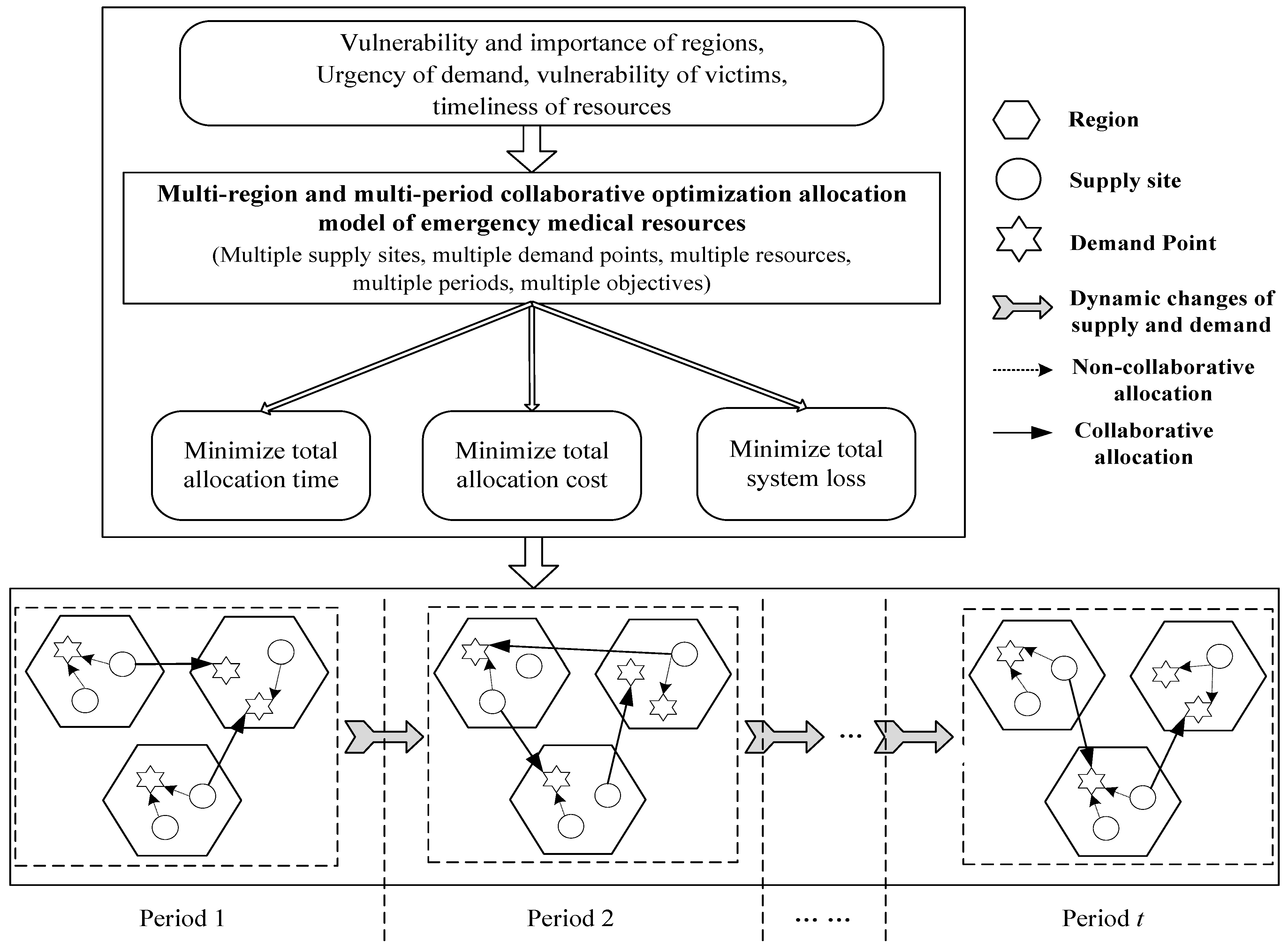

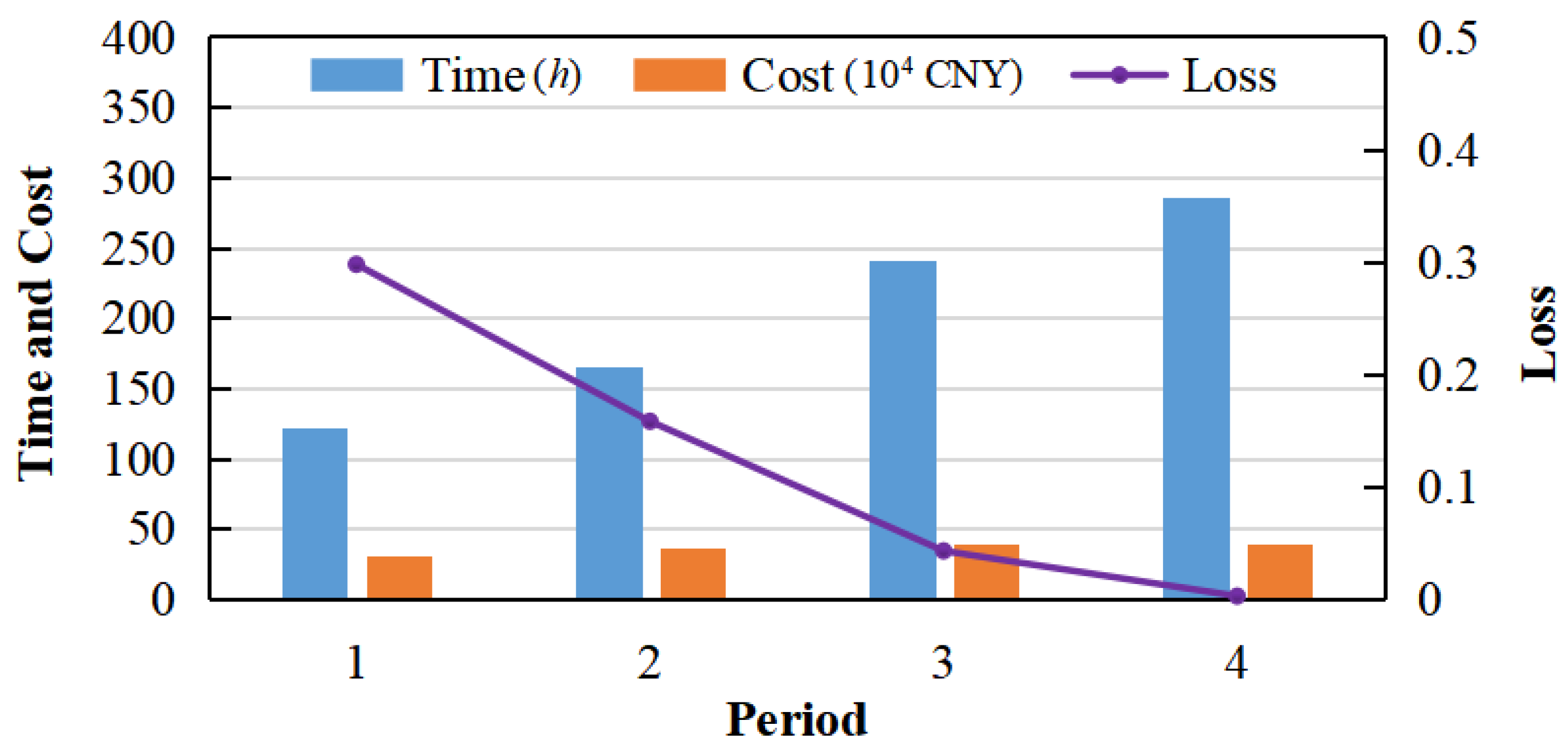
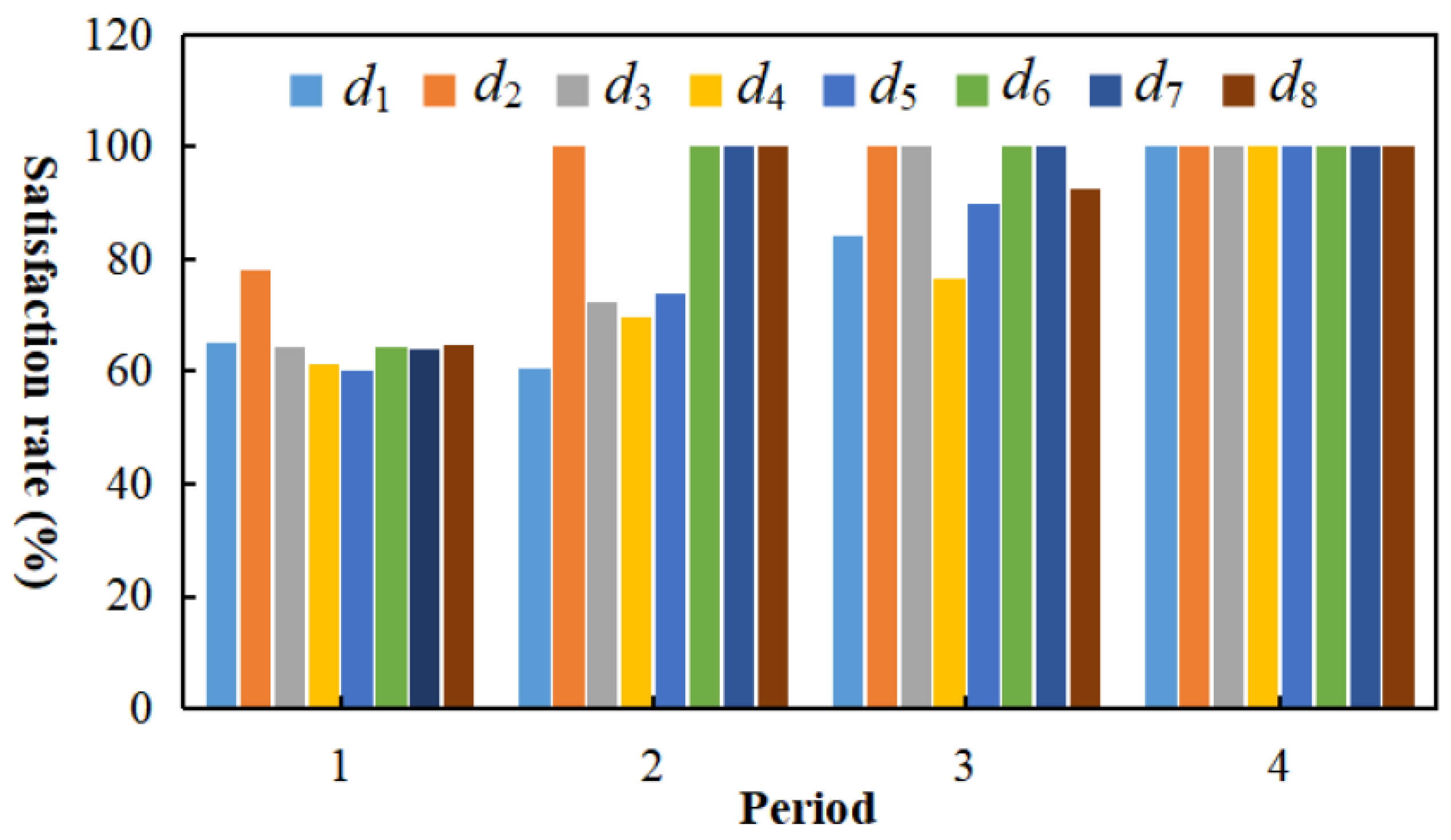
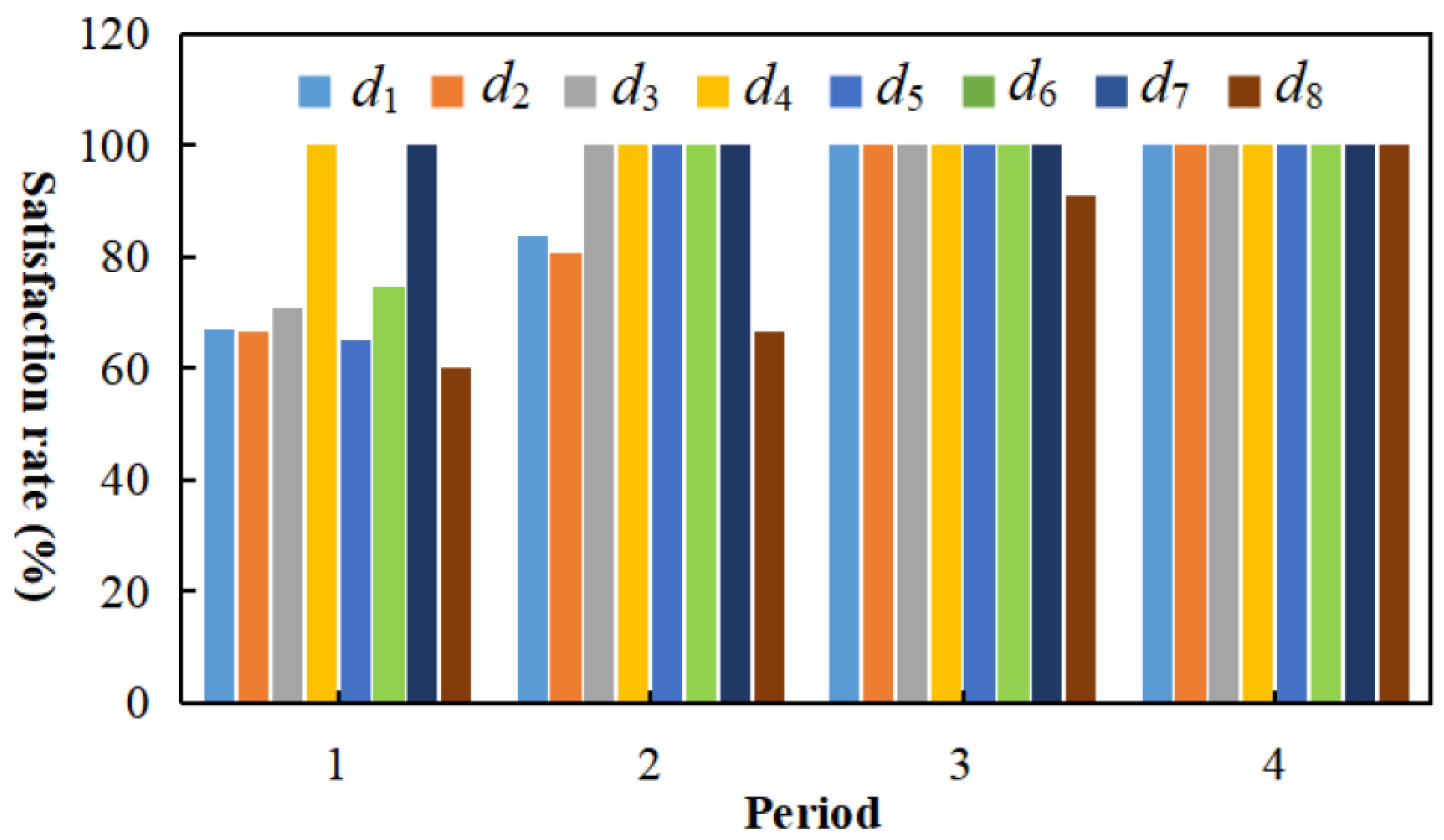


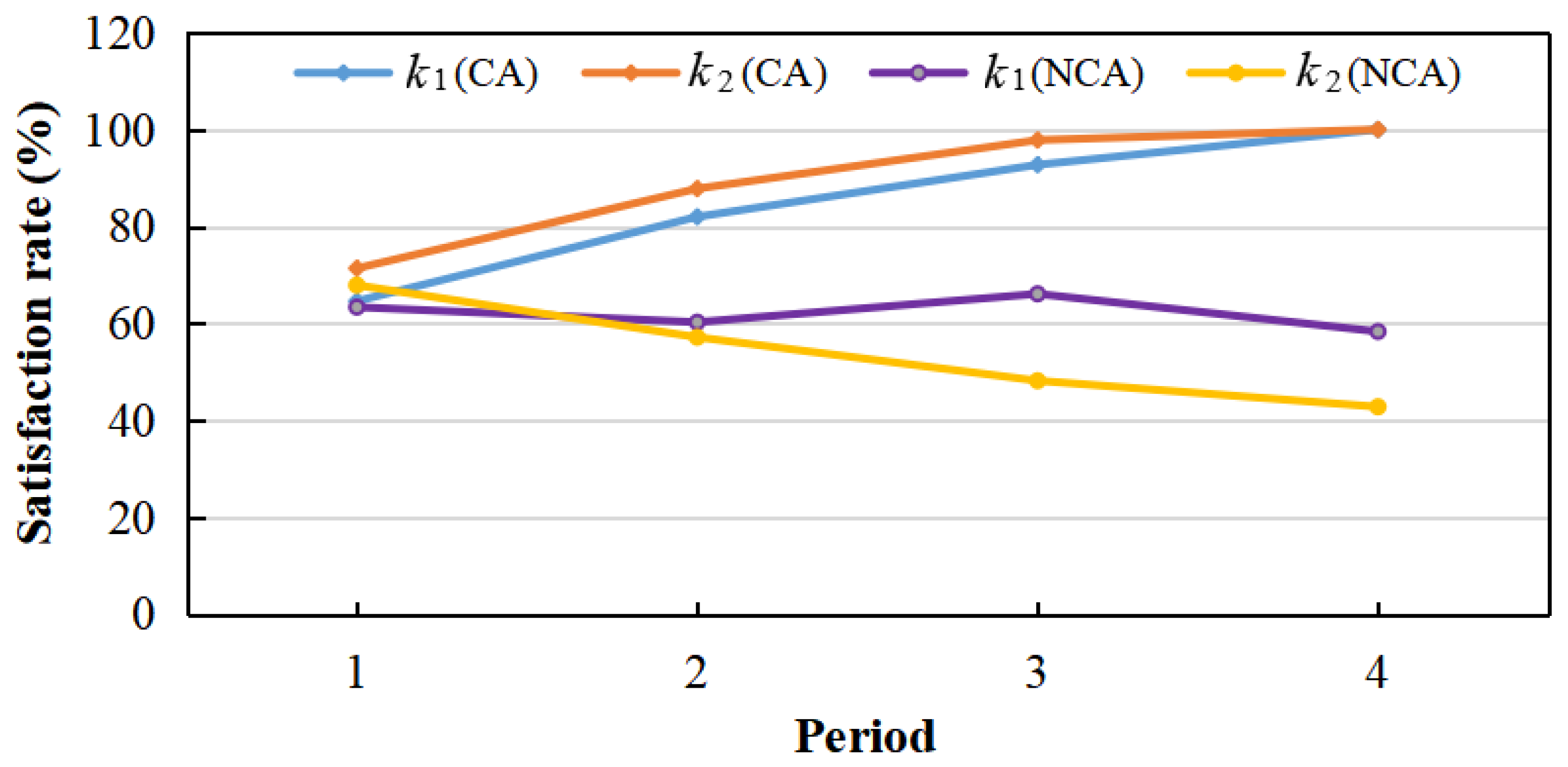

| Notation | Description |
|---|---|
| Sets | |
| Set of all regions affected by the epidemic, | |
| Set of regions requiring rescue operations, | |
| Set of all supply sites in the epidemic-affected region, | |
| Set of all demand points in the region requiring rescue operations, | |
| Set of types of emergency medical materials, | |
| Set of time periods of emergency medical material allocation, | |
| Parameters | |
| Fixed transportation cost per unit distance for allocating unit emergency medical materials from the supply site in the region to the demand point in the region during time period | |
| Variable transportation cost per unit distance for allocating unit medical materials from the supply site in the region to the demand point in the region during time period | |
| Unit penalty cost of shortage material at the demand point within the region requiring rescue operations at the end of time period | |
| Transportation time required to allocate materials from the supply site in the region to the demand point in the region requiring rescue operations during time period | |
| New demand for emergency medical materials at the demand point in the region requiring rescue operations at the beginning of period . Due to the rapid spread and incubation period of the epidemic, the specific new demand at each demand point in each period cannot be accurately known. The demand is represented by a random variable in this study. | |
| Actual demand for emergency medical materials at the demand point in the region requiring rescue operations during time period | |
| Latest amount of emergency medical materials raised at the supply site in the region at the beginning of time period | |
| Actual supply (available amount) of emergency medical materials raised at the supply site in the region during time period | |
| Inventory of materials at the supply site in the region at the end of time period | |
| Loading time of unit material at the supply point in the region during time period | |
| Unloading time of the unit material at the demand point in the region requiring rescue operations during time period | |
| Total mileage distance from the supply site in the region to the demand point in the region requiring rescue operations | |
| Maximum total amount of material that can go from the supply site in the region to the demand point in the region requiring rescue operations during time period | |
| Minimum allocation coverage rate of demand point for material in the region requiring rescue operations during time period | |
| Timeliness coefficient of emergency medical materials , that is, the available validity period of emergency medical materials. , a larger value indicates longer timeliness of the materials and more benefits for the development of rescue activities and the improvement of rescue effects | |
| Vulnerability coefficient of the demand point in the region requiring rescue operations during time period , which reflects the epidemic’s overall degree of impact. , a larger value indicates greater damage to demand point by the epidemic | |
| Importance coefficient of the demand point in the region requiring rescue operations during time period . , a larger value indicates a more important demand point. If the demand is not met, substantial loss will be incurred | |
| Characteristic coefficient of the victims at demand point in the region requiring rescue operations in the period, which mainly reflects the vulnerability of the victims. If there are more elderly people and children at the demand point, the vulnerability will be relatively high. , a larger value indicates a higher vulnerability of the victims at the demand point relative to other demand points | |
| Urgency coefficient of overall demand at the demand point in the region requiring rescue operations in the period. , a larger value indicates a more urgent overall demand at this point relative to other demand points | |
| Probability that the constraint conditions in are true | |
| Confidence level that makes constraints hold | |
| Decision Variables | |
| Amount of emergency medical materials allocated from the supply site in the region to the demand point in the region during time period | |
| Binary variable indicating whether materials are allocated to the demand point in the region from the supply site in the region during time period . If so, the value is 1; otherwise, it is 0 | |
| Unmet amounts (shortfalls) of materials at the demand point in the region requiring rescue operations during time period |
| Region | Supply Site | Period | Demand Point | Period | ||||||
|---|---|---|---|---|---|---|---|---|---|---|
| 1 | 2 | 3 | 4 | 1 | 2 | 3 | 4 | |||
| 3.5, 3 | 6, 4 | 9.5, 6 | 21, 7 | N (7, 3) N (10, 6) | N (9, 3) N (14, 3) | N (12, 6) N (19, 7) | N (15, 3) N (23, 8) | |||
| 2, 1 | 5, 2 | 6, 3 | 17, 4 | N (4, 3) N (8, 5) | N (6, 4) N (9, 3) | N (8, 5) N (12, 4) | N (10, 8) N (14, 3) | |||
| 0.5, 10 | 3, 18 | 3.5, 24 | 5, 38 | N (5, 2) N (9, 7) | N (6, 2) N (10, 3) | N (7, 4) N (12, 8) | N (9, 5) N (14, 5) | |||
| 0.5, 5 | 2, 10 | 2.5, 12 | 3, 13 | N (3, 2) N (7, 4) | N (5, 2) N (8, 3) | N (6, 3) N (10, 4) | N (8, 5) N (12, 3) | |||
| N (6, 3) N (9, 3) | N (7, 3) N (10, 2) | N (8, 4) N (11, 5) | N (10, 3) N (13, 3) | |||||||
| 0.5, 7 | 2, 21 | 3.5, 29 | 4, 63 | N (4, 3) N (8, 6) | N (5, 2) N (9, 4) | N (7, 4) N (11, 4) | N (9, 3) N (13, 5) | |||
| N (3, 2) N (5, 3) | N (4, 2) N (6, 3) | N (5, 3) N (8, 2) | N (7, 3) N (9, 3) | |||||||
| 5, 2 | 12, 5 | 17, 6 | 46, 7 | N (9, 6) N (12, 5) | N (10, 5) N (15, 6) | N (13, 6) N (19, 5) | N (16, 2) N (23, 5) | |||
| Material | Loading Time (Hour) | Unloading Time (Hour) | |
|---|---|---|---|
| 1 | 1 | (0.3, 0.2, 0.5, 0.4, 0.3, 0.5, 0.5, 0.2) | |
| 0.7 | 0.6 | (0.5, 0.4, 0.3, 0.3, 0.2, 0.2, 0.2, 0.5) |
| Region | Demand Point | p1 | p2 | p3 | p4 | ||
|---|---|---|---|---|---|---|---|
| s1 | s2 | s3 | s4 | s5 | s6 | ||
| 100, 1.1 | 90, 2 | 130, 0.8 | 90, 1.2 | 150, 1.9 | 120, 0.5 | ||
| 70, 0.4 | 60, 0.2 | 120, 1.4 | 70, 2 | 145, 1.3 | 125, 1.3 | ||
| 70, 1.4 | 50, 1.5 | 115, 0.4 | 60, 0.9 | 140, 2.1 | 130, 0.5 | ||
| 75, 1 | 60, 1.1 | 125, 0.4 | 65, 1.2 | 150, 1.7 | 110, 0.7 | ||
| 70, 1.7 | 70, 1.8 | 120, 0.3 | 70, 0.6 | 140, 2.3 | 115, 1 | ||
| 80, 0.3 | 60, 0.8 | 115, 1.5 | 60, 2.2 | 145, 0.8 | 110, 1.7 | ||
| 90, 0.4 | 80, 0.6 | 120, 1.7 | 70, 2.5 | 140, 0.7 | 120, 1.9 | ||
| 100, 1.5 | 100, 1.4 | 130, 0.9 | 110, 1.2 | 150, 2.4 | 120, 0.04 | ||
| Region | Demand Point | Period | |||
|---|---|---|---|---|---|
| 1 | 2 | 3 | 4 | ||
| (0.9, 0.9, 0.9,0.8) | (0.9, 0.8, 0.8, 0.7) | (0.8, 0.7, 0.7, 0.6) | (0.6, 0.5, 0.5, 0.4) | ||
| (0.8, 0.7, 0.8, 0.7) | (0.7, 0.6, 0.6, 0.6) | (0.6, 0.5, 0.4, 0.5) | (0.3, 0.3, 0.2, 0.3) | ||
| (0.8, 0.8, 0.9, 0.9) | (0.8, 0.7, 0.8, 0.8) | (0.7, 0.7, 0.7, 0.7) | (0.5, 0.5, 0.5, 0.5) | ||
| (0.7, 0.8, 0.8, 0.8) | (0.7, 0.7, 0.6, 0.7) | (0.6, 0.6, 0.4, 0.6) | (0.4, 0.2, 0.3, 0.4) | ||
| (0.8, 0.7, 0.8, 0.7) | (0.7, 0.6, 0.6, 0.6) | (0.5, 0.5, 0.5, 0.4) | (0.3, 0.3, 0.1, 0.2) | ||
| (0.8, 0.9, 0.9, 0.9) | (0.8, 0.8, 0.8, 0.8) | (0.7, 0.7, 0.7, 0.7) | (0.5, 0.5, 0.4, 0.5) | ||
| (0.9, 0.9, 0.9, 0.9) | (0.9, 0.8, 0.8, 0.8) | (0.8, 0.7, 0.7, 0.7) | (0.6, 0.5, 0.5, 0.5) | ||
| (0.8, 0.9, 0.8, 0.8) | (0.7, 0.7, 0.7, 0.6) | (0.5, 0.6, 0.6, 0.6) | (0.3, 0.4, 0.3, 0.4) | ||
| Material Timeliness | (1, 1) | (0.8, 0.9) | (0.8, 0.7) | (0.5, 0.5) | |
| Region | Demand Point | Allocation Mode | Period 1 | Period 2 | Period 3 | Period 4 |
|---|---|---|---|---|---|---|
() | NCA | ㊀ | ㊀ | ㊀ | ㊀ | |
| CA | ⊕ | ⊕ | ☑ | ☑ | ||
| NCA | ⊕ | ⊕ | ⊕ | ⊕ | ||
| CA | ⊕ | ⊕ | ☑ | ☑ | ||
() | NCA | ㊀ | ⊕ | ⊕ | ㊀ | |
| CA | ⊕ | ⊕ | ☑ | ☑ | ||
| NCA | ㊀ | ㊀ | ㊀ | ㊀ | ||
| CA | ⊕ | ⊕ | ⊕ | ☑ | ||
| NCA | ㊀ | ㊀ | ㊀ | ㊀ | ||
| CA | ⊕ | ⊕ | ⊕ | ☑ | ||
() | NCA | ㊀ | ㊀ | ㊀ | ㊀ | |
| CA | ⊕ | ☑ | ☑ | ☑ | ||
| NCA | ⊕ | ☑ | ☑ | ⊕ | ||
| CA | ⊕ | ☑ | ☑ | ☑ | ||
() | NCA | ㊀ | ㊀ | ㊀ | ㊀ | |
| CA | ⊕ | ⊕ | ⊕ | ☑ |
| Algorithms | Computing Time (s) | Average Convergence Value | Relative Convergence Error Rate (%) | ||||||
|---|---|---|---|---|---|---|---|---|---|
| ST | LT | AT | Z1 | Z2 | Z3 | Z1 | Z2 | Z3 | |
| GA | 135.27 | 163.19 | 150.22 | 836 | 152 | 0.55 | 2.51 | 4.61 | 9.1 |
| IAGA | 85.56 | 112.36 | 91.36 | 817 | 145.9 | 0.502 | 0.24 | 0.62 | 0.40 |
Publisher’s Note: MDPI stays neutral with regard to jurisdictional claims in published maps and institutional affiliations. |
© 2022 by the authors. Licensee MDPI, Basel, Switzerland. This article is an open access article distributed under the terms and conditions of the Creative Commons Attribution (CC BY) license (https://creativecommons.org/licenses/by/4.0/).
Share and Cite
Wang, Y.; Zhu, X. A Multi-Regional Collaborative Optimization Model of Emergency Medical Materials for Responding to COVID-19. Processes 2022, 10, 1488. https://doi.org/10.3390/pr10081488
Wang Y, Zhu X. A Multi-Regional Collaborative Optimization Model of Emergency Medical Materials for Responding to COVID-19. Processes. 2022; 10(8):1488. https://doi.org/10.3390/pr10081488
Chicago/Turabian StyleWang, Yanyan, and Xiaoxin Zhu. 2022. "A Multi-Regional Collaborative Optimization Model of Emergency Medical Materials for Responding to COVID-19" Processes 10, no. 8: 1488. https://doi.org/10.3390/pr10081488
APA StyleWang, Y., & Zhu, X. (2022). A Multi-Regional Collaborative Optimization Model of Emergency Medical Materials for Responding to COVID-19. Processes, 10(8), 1488. https://doi.org/10.3390/pr10081488






